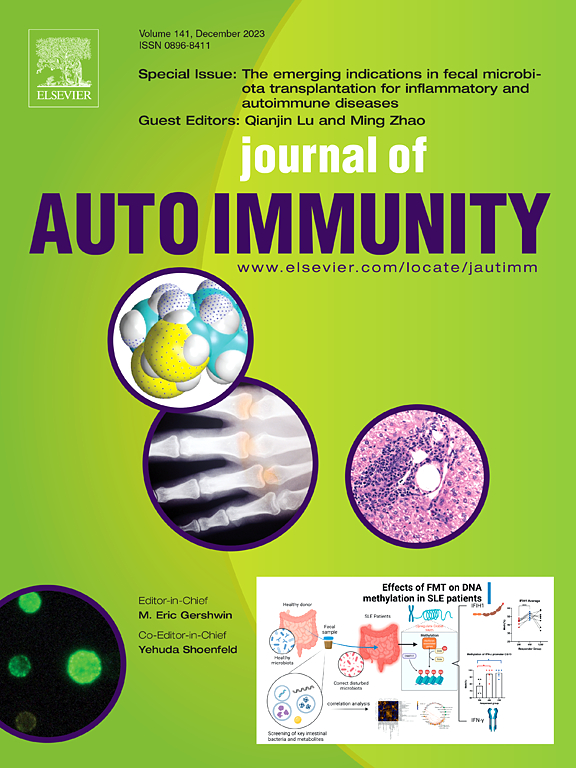Peripheral immune profiling highlights a dynamic role of low-density granulocytes in myasthenia gravis
IF 7
1区 医学
Q1 IMMUNOLOGY
引用次数: 0
Abstract
Background
Myasthenia gravis (MG) is an autoimmune neuromuscular disease marked by dysregulation of several immune cell populations. Here we explored peripheral immune landscape, particularly the role of low-density granulocytes (LDGs).
Methods
Single-cell and bulk RNA sequencing analyzed peripheral immune cells from MG patients pre- (n = 4) and after treatment (n = 2), as well as healthy controls (n = 3). Flow cytometry was employed for validating LDG subsets, and various functional assays were conducted to assess their impact on T cell proliferation and differentiation, NET formation, and ROS production.
Results
Single-cell analysis highlighted a shift towards inflammatory Th1/Th17/Tfh subsets, an intense interferon-mediated immune response, and an expansion of immature myeloid subsets in MG. Flow cytometry showed increased LDGs correlated with disease severity. Unlike myeloid-derived suppressor cells, MG LDGs do not restrict T cell proliferation but induce a pro-inflammatory Th1/Th17 response. They also display enhanced spontaneous neutrophil extracellular traps (NETs) formation and basal reactive oxygen species (ROS) production. LDGs decreased after intravenous immunoglobulin and increased after prolonged immunotherapy in minimal manifestation status (MM), with reduced pro-inflammatory activity. Bulk RNA sequencing revealed significant transcriptional differences in LDGs, especially in cell cycle and granule protein genes.
Conclusion
Peripheral immune profiling sheds light on the intricate role of LDGs in MG. These cells, as a distinct subtype of neutrophils with a proinflammatory phenotype, are notable increased in MG, exacerbating chronic inflammation. Furthermore, immunotherapy expanded LDGs but reduced their proinflammatory capacities. The complex interplay of LDGs in MG underscores their potential as biomarkers and therapeutic targets.
外周免疫分析强调了低密度粒细胞在重症肌无力中的动态作用
背景重症肌无力(MG)是一种自身免疫性神经肌肉疾病,以几种免疫细胞群失调为特征。在这里,我们探讨了外周免疫景观,特别是低密度粒细胞(LDGs)的作用。方法单细胞和大量RNA测序分析了MG患者治疗前(n = 4)和治疗后(n = 2)以及健康对照(n = 3)的外周免疫细胞。流式细胞术用于验证LDG亚群,并进行了各种功能测定以评估其对T细胞增殖和分化,NET形成和ROS产生的影响。结果单细胞分析强调了炎症性Th1/Th17/Tfh亚群的转变,干扰素介导的强烈免疫反应,以及MG中未成熟髓细胞亚群的扩大。流式细胞术显示LDGs升高与疾病严重程度相关。与髓源性抑制细胞不同,MG LDGs不限制T细胞增殖,但诱导促炎Th1/Th17反应。它们还表现出增强的自发中性粒细胞胞外陷阱(NETs)的形成和基础活性氧(ROS)的产生。LDGs在静脉注射免疫球蛋白后降低,在最小表现状态(MM)下延长免疫治疗后升高,促炎活性降低。大量RNA测序显示,LDGs的转录差异显著,特别是在细胞周期和颗粒蛋白基因上。结论外周免疫分析揭示了LDGs在MG中的复杂作用。这些细胞作为嗜中性粒细胞的一种独特亚型,具有促炎表型,在MG中显著增加,加剧慢性炎症。此外,免疫治疗扩大了ldg,但降低了它们的促炎能力。LDGs在MG中的复杂相互作用强调了它们作为生物标志物和治疗靶点的潜力。
本文章由计算机程序翻译,如有差异,请以英文原文为准。
求助全文
约1分钟内获得全文
求助全文
来源期刊

Journal of autoimmunity
医学-免疫学
CiteScore
27.90
自引率
1.60%
发文量
117
审稿时长
17 days
期刊介绍:
The Journal of Autoimmunity serves as the primary publication for research on various facets of autoimmunity. These include topics such as the mechanism of self-recognition, regulation of autoimmune responses, experimental autoimmune diseases, diagnostic tests for autoantibodies, as well as the epidemiology, pathophysiology, and treatment of autoimmune diseases. While the journal covers a wide range of subjects, it emphasizes papers exploring the genetic, molecular biology, and cellular aspects of the field.
The Journal of Translational Autoimmunity, on the other hand, is a subsidiary journal of the Journal of Autoimmunity. It focuses specifically on translating scientific discoveries in autoimmunity into clinical applications and practical solutions. By highlighting research that bridges the gap between basic science and clinical practice, the Journal of Translational Autoimmunity aims to advance the understanding and treatment of autoimmune diseases.
 求助内容:
求助内容: 应助结果提醒方式:
应助结果提醒方式:


